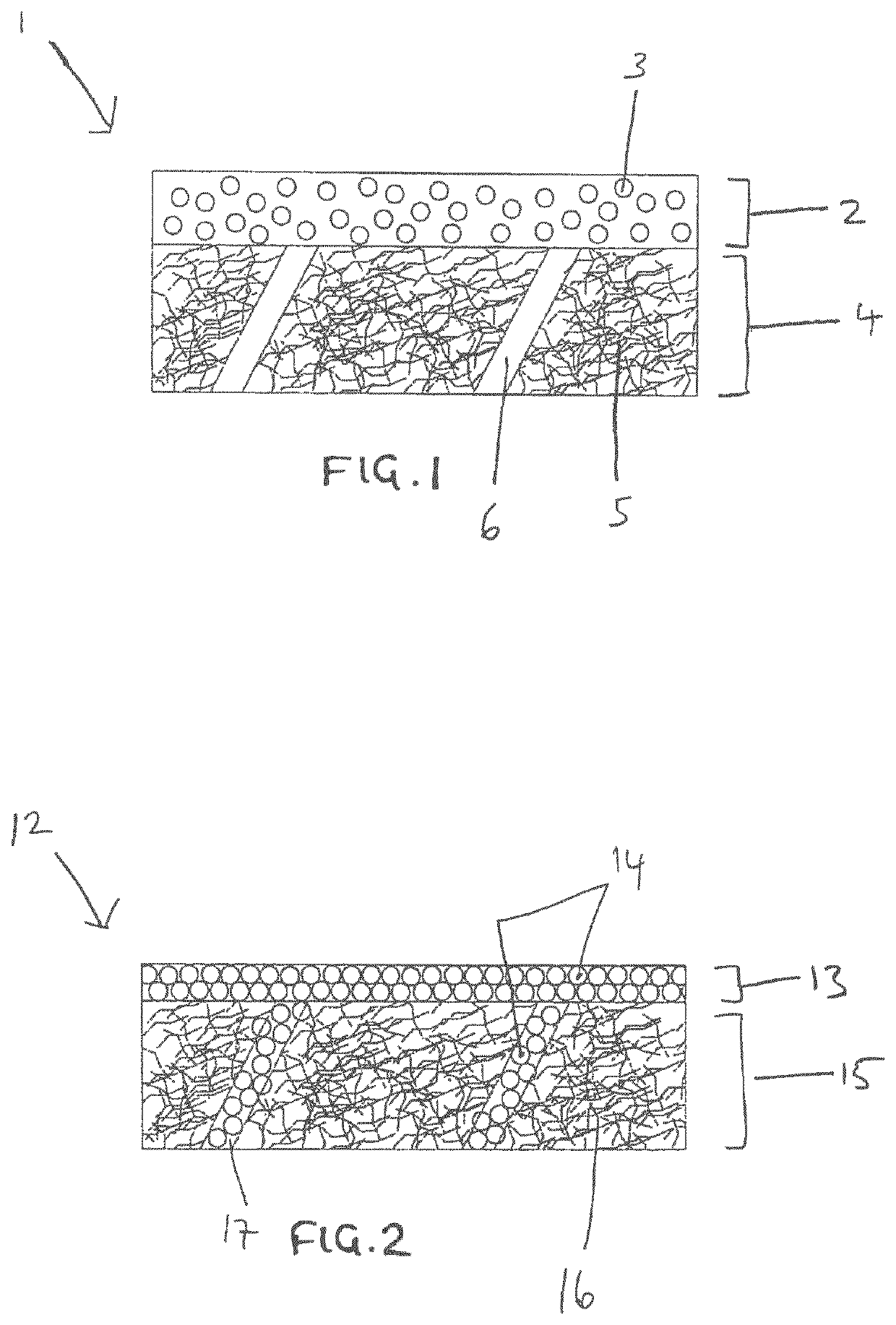Moulding material for composite panels
a composite panel and moulding technology, applied in the direction of synthetic resin layered products, transportation and packaging, chemistry apparatus and processes, etc., can solve the problems of higher differential in fibre modulus, more pronounced problem in carbon composites, and late paint defects in surface layers, so as to reduce resin rich zones, reduce shrinkage and distortion, and improve the effect of quality
- Summary
- Abstract
- Description
- Claims
- Application Information
AI Technical Summary
Benefits of technology
Problems solved by technology
Method used
Image
Examples
example 1
[0134]A preform was manufactured and press-cured. The preform consisted of 3 plies of prepreg material:[0135]1. a prepreg containing a 180 micron surface resin layer weighing 290 gsm and containing 38% pbw (22% by vol) particulate filler in contact with the fibrous layer of material B. The resin side was orientated towards the A-surface of the tool;[0136]2. a syntactic prepreg layer of 800 gsm; and[0137]3. The same prepreg as ply 1 but with the resin side was orientated toward the B-surface of the tool.
[0138]The panel had a measured cured ply thickness of 1.29 mm and weight of 1.63 Kg / m after the resin bleed-out from processing. The panel had a flexural modulus of 23.2 GPa and a flexural strength of 437.40 MPa. The panel had the equivalent stiffness of a 0.63 mm steel plate weighing 5.01 Kg / m2, giving a 67% weight saving.
[0139]The panel had a good surface finish. It was prepared for paint using the low surface preparation method and assessed to have an acceptable finish to topcoat f...
example 2
[0140]A preform was manufactured and press-cured. The preform consisted of 4 plies of prepreg material:[0141]1. a prepreg containing a 282 micron surface resin layer weighing 452 gsm and containing 38% pbw (22% by vol) particulate filler in contact with the fibrous layer of material B. The resin side was orientated towards the A-surface of the tool;[0142]2. a prepreg formed of from cast films of ST160 prepreg resin in contact with the fibrous layer of material B to give a prepreg containing 300 gsm resin film containing no particulate filler;[0143]3. the same prepreg as ply 2[0144]4. the same prepreg as ply 1 but with the resin side orientated toward the B-surface of the tool.
[0145]The panel had a good surface finish. It was prepared for paint using the low surface preparation method and assessed to have an acceptable finish to topcoat for an A-class panel.
example 3
[0146]A preform was manufactured and press-cured. The preform consisted of 4 plies of prepreg material:[0147]1. a prepreg containing a 282 micron surface resin layer weighing 452 gsm and containing 38% pbw (22% by vol) particulate filler in contact with the fibrous layer of material B. The resin side was orientated towards the A-surface of the tool;[0148]2. a prepreg formed of from cast films of ST160 prepreg resin in contact with the fibrous layer of material B to give a prepreg containing 450 gsm resin film containing no particulate filler;[0149]3. the same prepreg as ply 2;[0150]4. the same prepreg as ply 1 but with the resin side orientated toward the B-surface of the tool.
[0151]The panel had a good surface finish. It was prepared for paint using the low surface preparation method and assessed to have an acceptable finish to topcoat for an A-class panel.
PUM
| Property | Measurement | Unit |
|---|---|---|
| thickness | aaaaa | aaaaa |
| thickness | aaaaa | aaaaa |
| pressure | aaaaa | aaaaa |
Abstract
Description
Claims
Application Information
 Login to View More
Login to View More - R&D
- Intellectual Property
- Life Sciences
- Materials
- Tech Scout
- Unparalleled Data Quality
- Higher Quality Content
- 60% Fewer Hallucinations
Browse by: Latest US Patents, China's latest patents, Technical Efficacy Thesaurus, Application Domain, Technology Topic, Popular Technical Reports.
© 2025 PatSnap. All rights reserved.Legal|Privacy policy|Modern Slavery Act Transparency Statement|Sitemap|About US| Contact US: help@patsnap.com



